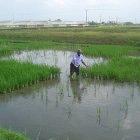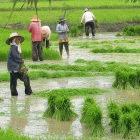Navigation
Flood-tolerant Rice Offers Relief for World's Poorest Farmers
Farmers should soon have access to a new strain of flood-resistant rice, say scientists.
 |
| An IRRI scientist with the 'waterproof' rice either side of him. Although rice thrives in standing water, like all crops it will die if completely submerged for more than a few days. The development and cultivation of the new varieties are expected to increase food security for 70 million of the world's poorest people, and may reduce yield losses from weeds in areas such as the United States, where rice is seeded in flooded fields. Photo Credit: IRRI |
Farmers should soon have access to a new strain of flood-resistant rice, say scientists.
The development was discussed at the 3rd steering committee meeting of the Irrigated Rice Research Consortium of the International Rice Research Institute (IRRI) in Hanoi, Vietnam 8–9 October, 2007.
A large portion of Asian rice land is located in deltas and low-lying areas that are at risk from flooding during the monsoon season, and climate change intensifies these risks, said Reiner Wassmann, coordinator of the Rice and Climate Change Consortium of IRRI.
Crop scientists estimate that annual flooding leads to losses worth US$1 billion across south and South-East Asia.
Wassmann told SciDev.Net that a flood-resistant rice variety called Swarna Submergence 1 should reach farmers by 2009. The plant carries the sub1a gene that enables it to be submerged for up to 17 days.
Scientists led by David Mackill of IRRI and Pamela Ronald of the US-based University of California are working on the flood-resistant rice and are currently conducting field trials in several Asian countries.
 |
| Rice is the world's most important crop Photo credit: IRD / Maeght |
According to IRRI, global rice prices have hit record highs while supply has plummeted to its lowest levels in a decade.
Around 60 international rice scientists from 13 countries gathered at the meeting to discuss improved rice varieties and innovative crop management techniques to help farmers address problems of growing rice in a changing climate, along with scarce water resources.
"We acknowledged the urgency of developing new varieties that can cope with flooding as well as higher temperatures because rice production may become unfavourable in some countries, especially vulnerable regions that are affected by sea level rise," Wassmann said.
Also at the conference, IRRI and the Vietnam Academy of Agricultural Sciences presented a study showing that low lift irrigation pumps — where water is pumped onto land difficult to serve by a gravity canal system — and drip irrigation can help to reduce water use between 15–20 per cent during the dry season, while boosting productivity by up to 15 per cent.
Article by: Imelda V. Abano
12 October 2007
Source: SciDev.Net, Science and Development Network
Results of this study initially appeared in the August 10, 2006 issue of the journal Nature.
Rice is the primary food for more than three billion people around the world. Approximately one-fourth of the global rice crop is grown in rainfed lowland plots that are prone to seasonal flooding. These seasonal flash floods are extremely unpredictable and may occur at any growth stage of the rice crop.
Although rice is the only cereal crop that can withstand submergence at all, most rice varieties will die if fully submerged for too long.
When the plant is covered with water, its oxygen and carbon dioxide supplies are reduced, which interferes with photosynthesis and respiration. Because the submerged plants lack the air and sunlight they need to function, growth is inhibited, and the plants will die if they remain under water for more than four days.
During any given year, yield losses resulting from flooding in these lowland areas may range from 10 percent to total destruction, depending on the water depth, age of the plant, how long the plants are submerged, water temperature, rate of nitrogen fertilizer use, and other environmental factors. Annual crop loss has been estimated at more than $1 billion.
"For half a century, researchers have been trying to introduce submergence tolerance into the commonly grown rice varieties through conventional breeding," said rice geneticist and study co-author David Mackill, who heads the Division of Plant Breeding, Genetics, and Biotechnology at the International Rice Research Institute.
"Several traditional rice varieties have exhibited a greater tolerance of submergence, but attempts to breed that tolerance into commercially viable rice failed to generate successful varieties,” he said.
"We're especially pleased that we have been able to use the latest advances in molecular biology to help improve the lives of the world's poor," Mackill added. "We're confident that even more important discoveries like this are in the pipeline."
Notes:
Time lapse video of Swarna Submergence 1, a time-lapse video, done from 14 June to 27 September 2007 in an IRRI research plot, Prepared by IRRI’s photography and video section: 1:55 video on YouTube.
The International Rice Research Institute (IRRI) is the world’s leading rice research and training center. Based in the Philippines and with offices in 10 other Asian countries, it is an autonomous, nonprofit institution focused on improving the well-being of present and future generations of rice farmers and consumers, particularly those with low incomes, while preserving natural resources. IRRI is one of 15 centers funded through the Consultative Group on International Agricultural Research (CGIAR), an association of public and private donor agencies. Please visit the CGIAR website (www.cgiar.org) for more information.
IRD : L'Institut de recherché pour le développement a pour mission de développer des projets scientifiques centrés sur les relations entre l'homme
et son environnement dans la zone intertropicale.
Search
Latest articles
Agriculture
- World Water Week: Healthy ecosystems essential to human health: from coronavirus to malnutrition Online session Wednesday 24 August 17:00-18:20
- World Water Week: Healthy ecosystems essential to human health: from coronavirus to malnutrition Online session Wednesday 24 August 17:00-18:20
Air Pollution
- "Water and Sanitation-Related Diseases and the Changing Environment: Challenges, Interventions, and Preventive Measures" Volume 2 Is Now Available
- Global Innovation Exchange Co-Created by Horizon International, USAID, Bill and Melinda Gates Foundation and Others
Biodiversity
- It is time for international mobilization against climate change
- World Water Week: Healthy ecosystems essential to human health: from coronavirus to malnutrition Online session Wednesday 24 August 17:00-18:20
Desertification
- World Water Week: Healthy ecosystems essential to human health: from coronavirus to malnutrition Online session Wednesday 24 August 17:00-18:20
- UN Food Systems Summit Receives Over 1,200 Ideas to Help Meet Sustainable Development Goals
Endangered Species
- Mangrove Action Project Collaborates to Restore and Preserve Mangrove Ecosystems
- Coral Research in Palau offers a “Glimmer of Hope”
Energy
- Global Innovation Exchange Co-Created by Horizon International, USAID, Bill and Melinda Gates Foundation and Others
- Wildlife Preservation in Southeast Nova Scotia
Exhibits
- Global Innovation Exchange Co-Created by Horizon International, USAID, Bill and Melinda Gates Foundation and Others
- Coral Reefs
Forests
- NASA Satellites Reveal Major Shifts in Global Freshwater Updated June 2020
- Global Innovation Exchange Co-Created by Horizon International, USAID, Bill and Melinda Gates Foundation and Others
Global Climate Change
- It is time for international mobilization against climate change
- It is time for international mobilization against climate change
Global Health
- World Water Week: Healthy ecosystems essential to human health: from coronavirus to malnutrition Online session Wednesday 24 August 17:00-18:20
- More than 400 schoolgirls, family and teachers rescued from Afghanistan by small coalition
Industry
- "Water and Sanitation-Related Diseases and the Changing Environment: Challenges, Interventions, and Preventive Measures" Volume 2 Is Now Available
- Global Innovation Exchange Co-Created by Horizon International, USAID, Bill and Melinda Gates Foundation and Others
Natural Disaster Relief
- STOP ATTACKS ON HEALTH CARE IN UKRAINE
- Global Innovation Exchange Co-Created by Horizon International, USAID, Bill and Melinda Gates Foundation and Others
News and Special Reports
- World Water Week: Healthy ecosystems essential to human health: from coronavirus to malnutrition Online session Wednesday 24 August 17:00-18:20
- STOP ATTACKS ON HEALTH CARE IN UKRAINE
Oceans, Coral Reefs
- World Water Week: Healthy ecosystems essential to human health: from coronavirus to malnutrition Online session Wednesday 24 August 17:00-18:20
- Mangrove Action Project Collaborates to Restore and Preserve Mangrove Ecosystems
Pollution
- Zakaria Ouedraogo of Burkina Faso Produces Film “Nzoue Fiyen: Water Not Drinkable”
- "Water and Sanitation-Related Diseases and the Changing Environment: Challenges, Interventions, and Preventive Measures" Volume 2 Is Now Available
Population
- "Water and Sanitation-Related Diseases and the Changing Environment: Challenges, Interventions, and Preventive Measures" Volume 2 Is Now Available
- "Water and Sanitation-Related Diseases and the Changing Environment: Challenges, Interventions, and Preventive Measures" Volume 2 Is Now Available
Public Health
- Honouring the visionary behind India’s sanitation revolution
- Honouring the visionary behind India’s sanitation revolution
Rivers
- World Water Week: Healthy ecosystems essential to human health: from coronavirus to malnutrition Online session Wednesday 24 August 17:00-18:20
- Mangrove Action Project Collaborates to Restore and Preserve Mangrove Ecosystems
Sanitation
- Honouring the visionary behind India’s sanitation revolution
- Honouring the visionary behind India’s sanitation revolution
Toxic Chemicals
- "Water and Sanitation-Related Diseases and the Changing Environment: Challenges, Interventions, and Preventive Measures" Volume 2 Is Now Available
- Actions to Prevent Polluted Drinking Water in the United States
Transportation
- "Water and Sanitation-Related Diseases and the Changing Environment: Challenges, Interventions, and Preventive Measures" Volume 2 Is Now Available
- Urbanization Provides Opportunities for Transition to a Green Economy, Says New Report
Waste Management
- Honouring the visionary behind India’s sanitation revolution
- Honouring the visionary behind India’s sanitation revolution
Water
- Honouring the visionary behind India’s sanitation revolution
- Honouring the visionary behind India’s sanitation revolution
Water and Sanitation
- Honouring the visionary behind India’s sanitation revolution
- Honouring the visionary behind India’s sanitation revolution

